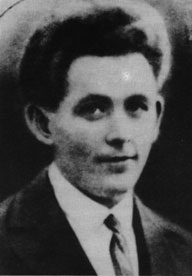|
Chomsky
Answers Eight Question on Kibbutzim form by Nikos
Raptis
"Hitler's
Americanization" by Nikos Raptis
European
Labor by Nikos Raptis
The
Pnyx by Nikos Raptis
Simon
Wiesenthal Centre
The
Holocaust/O Porrajmos
Roma
and the Holocaust
|

Johann Georg Elser
(1903-1945): "I wanted through my act to prevent more
bloodshed".
Johann Georg Elser was born in
the German Village of Hermaringen in 1903. At the age of
fourteen he was apprenticed as a (lathe) turner in a local
iron factory. In 1922 he passed his journeyman's exam as a
cabinet-maker and became a specialist in carpentry and metal
work. For the next decade Elser lived as a wandering
craftsman, sometimes working in clock factories or repairing
furniture. In 1928-9 he joined the militant communist group
"Rotfrontkaempferbund" (Red Front Fighters' Association).
Except for playing in its brass band he did not engage in
Communist party activities. After 1933 he was considered an
ex-Communist.
In 1938 Elser was alarmed by
the Munich agreements and terrified by the prospect of a
second World War, having experienced the first World War as
a teenager. Elser, a reserved, slow-spoken individual, in
the autumn of the same year of 1938, decided to assassinate
Hitler. He planned the assassination attempt meticulously,
accumulating a stock of explosives, designing a special
clock mechanism and hiding his apparatus in a wooden column
behind the speaker's rostrum in the Munich
"Buergerbraeukeller" where Hitler was due to speak on
November 8, 1939, delivering his annual address before the
"Old Fighters" in commemoration of the "Putsch" of 1923,
which had started in the same "Buergerbraeukeller". (Note:
The "Buergerbraeukeller" is a huge beer hall where the
Germans down enormous quantities of beer in noisy
camaraderie, while discharging the "processed" beer at
spacious lavatories on the one side of the hall, with
immediate access from the hall.)`
On November 8, 1939 Hitler was
speaking at the "Buergerbraeukeller". His speech normally
ended about 10 p.m., but that day he left at 9.07 to catch
his special train. The bomb exploded at 9.20 destroying half
the hall, killing seven people and wounding sixty-three.
Next day Hitler claimed that an "inner voice" had told him
to get out and on the same day he decided to launch a
western offensive ! Elser was arrested the same evening of
the attempt at the Swiss frontier, brought to Berlin, the
Gestapo, etc. Subsequently, he was sent to the Sachsenhausen
concentration camp as "Hitler's special prisoner," He was
given a carpenter's bench and allowed to make what he
pleased. In 1944 he was moved to Dachau and kept alive,
possibly in the hope of being used in a show trial after the
war. On April 9, 1945, only 29 days before the Germans
surrendered, he was murdered by the Gestapo on a secret
order from Himmler, and his death was attributed to an
allied bombing raid.
The Elser case is unknown not
only to the general public but there is almost nothing in
the works of scholars, with expertise on Hitler and Nazism.
For example, in the work of Ian Kershaw, Professor at the
University of Sheffield in England, there is no mention of
Elser's name (The Hitler Myth, Oxford, 1987;
Popular Opinion & Political Dissent in the Third
Reich, Oxford, 1983). However, in a recent interview to
the German magazine Der Spiegel Kershaw when asked if
Elser is "his hero at that time," he answered that Elser is
" certainly one of the few (heroes), probably just because
he was an outsider. Elser is no political person, he wanted
to kill Hitler, to put an end to the war, simply that.
Compared to the (Nazi) officers, who hesitated again and
again, Elser is a luminous figure." (Der Spiegel,
34/2000, p.58)
The Germans have repressed the
Elser case for more than 60 years. Yet, there are
exceptions. One is that of the 53-year old artist Wolfram
Kastner of Munich, whose work as a painter aims to "make
visible, what the people do not want to see." In order to
make "visible" The act of Elser, Kastner, on November 8,
1999, sprayed in four different sites of the city of Munich,
a sentence taken from the minutes of the Esler trial: "I
wanted through my act to prevent more bloodshed." (Elser's
words). One of the sites was the monument dedicated to the
"Resistance against the Nazis." The monument consists of a
black stone slab on which are engraved the names of those
that resisted Nazism. Elser's name is not among them!
Kastner sprayed Elser's name on the monument with white
paint. Next day the German Rolf Hochhuth gave a lecture in
the Bavarian Academy for the Fine Arts. The title of the
lecture : "Johann Georg Elser - the most solitary among us
Germans."
It seems that in the Elser case
there are still some things that demand to become "visible',
or should be analyzed at a deeper level. What would have
happened if Elser succeeded in eliminating Hitler? Would the
(US supported, in the 1920s and 1930s,) Nazi institutions
have found a Hitler substitute and continued W.W.II? Can the
act of an individual (Elser) have so vast effects as to stop
W.W.II?
PS Who is going to make a film
on the Elser case?
Nikos
Raptis was born
in Athens, Greece, in 1930. He is a civil engineer. For the
last 30 years he has been writing on social matters for
papers and magazines (mainly) in Greece. He is the author of
"Let Us Talk About Earthquakes, Floods and...the Streetcar"
(1981) and "The Nightmare of the Nukes"(1986), both in
Greek. He, also, translated into Greek and published Noam
Chomsky's "Year 501" and "Rethinking Camelot". He lives in
Athens, Greece.
© Nikos Raptis
|
